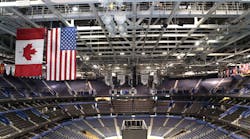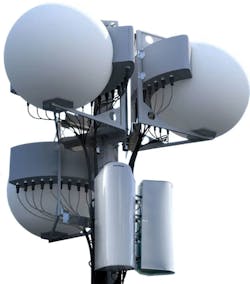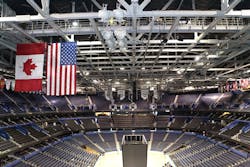This article appeared in Microwaves & RF and has been published here with permission.
What you’ll learn:
- Solutions to the challenge of meeting ever-growing demand for more mobile connectivity to match more powerful apps and services.
- How lens antennas provide better venue cellular coverage and capacity at a lower cost and with better aesthetics than traditional methods.
- How one lens antenna can create up to 48 distinct, precise beams that deliver better broadband capacity than any array antenna or traditional antenna.
The mobile service industry has one truth that continues to drive innovation: Demand for bandwidth will always keep increasing. This is especially true at arenas and stadiums, where sports fans and live-music fans continue to be the heaviest users of wireless services, with streaming and social media use expanding.
This creates a dilemma for venue owners and operators, and their connectivity services partners. They must figure out how to meet the ever-growing demand for connectivity and provide support as mobile phones and their apps and services continue to increase in power and data requirements. In addition to the existing challenge to provide enough bandwidth for instant messaging and live video communications, there’s the advent of live mobile gaming inside arenas and event venues, which will further drive demand for lower latency and greater throughput.
Venues of all shapes and sizes have already tried different methods to address the problem, but existing technologies provide limited options. Many venues typically add more antennas to the cellular network as a first effort, but even that strategy runs out of room eventually due to signal interference or venue real-estate issues.
Other venues have tried deploying cellular antennas in under-seat or handrail enclosures. While this can improve the density of the network coverage, the strategy can also introduce new RF challenges with seat construction materials (oftentimes, metal mounting rails) that can significantly add to the cost of deployment. Under-seat deployments usually require concrete core drills and additional behind-the-scenes conduit runs that quickly run up the price tag.
Thankfully, a new solution is available. The novel technology and deployment method could dramatically increase venue cellular coverage and capacity at a lower cost and with better aesthetics than traditional methods. By using lens antennas mounted in ceiling or roof structures, venues gain the advantage of each device’s multi-radio infrastructure to provide multiple direct line-of-sight beams that can be aimed precisely at specific seating sections.
Each lens antenna is able to effectively replace multiple single-beam antennas, leading to great cost and operational savings through fewer active components. Lens antennas also basically eliminate the interference issues caused when client devices can “see” multiple radios inside a venue.
Exceptional Performance with a Distinct Shape
Lens antennas are mainly shaped like large balls, with diameters ranging from 1 foot to 6 feet across (Fig. 1). Over the past few years, MatSing lens antennas have been used in a number of deployments, including temporary installations at events such as the Coachella Valley Music and Arts Festival and at the 2017 presidential inauguration.
The antennas have also become a significant part of the in-venue cellular solution of professional sports venues, including Amalie Arena, home of the NHL's Tampa Bay Lightning (Fig. 2), and Allegiant Stadium, home of the NFL's Las Vegas Raiders. More deployments are already in progress.
Based on a theory from the 1940s known as the Luneberg Lens, the lens antennas' multiple beam draws its advantages from the distinct shape of the lens, which can focus radio frequency from any direction. You can have multiple beams coming from a single lens because that lens is symmetrical. With our current materials and technology, one lens antenna can create up to 48 distinct, precise beams that provide better broadband capacity than any array antenna or traditional antenna.
Lens antennas can also reach consumer devices at a much farther distance than regular in-building antennas. This allows the lens antennas to be deployed in the roof, ceiling, or catwalk structures, avoiding the seating bowls and public areas. Traditional cellular deployments require advanced testing and tuning to limit the interference between multiple antennas and radios, while lens antennas could be simply tuned by using laser pointers. Their line-of-sight broadcast directions can’t be "heard" by devices outside the narrow beams of coverage.
With up to 48 radios possible inside each lens antenna, venues are able to significantly increase capacity and coverage while using far fewer cable and power runs to each active location. Adding more lens antennas provides additional capacity, and they can be placed closely together since the directional focus of the beams prevents interference between devices. Lens-antenna deployments also work well in hybrid scenarios, as an adjunct to an existing distributed-antenna-system (DAS) infrastructure.
In addition, lens antennas deliver another desirable effect from an aesthetics standpoint—they keep the equipment out of the view of the venue guests. The antennas are easily concealed to blend in with the background of roof or ceiling areas, and they can be painted any color.
Improved Performance and Easier Deployment
Accurately predicting what venues will need when it comes to cellular and wireless connectivity needs is at times more art than science. However, the simple principle that demand will continue to grow should always be taken into account in future planning for all stadium and arena IT teams.
And there will be always be the need to balance costs with desired performance and acceptable levels of coverage. Thus, any venue in the process of evaluating changes or improvements to its wireless ecosystem would be wise to consider the lens-antenna advantage of improved performance in an easier deployment method at a lower overall price.
Bo Larsson is CEO of MatSing.


